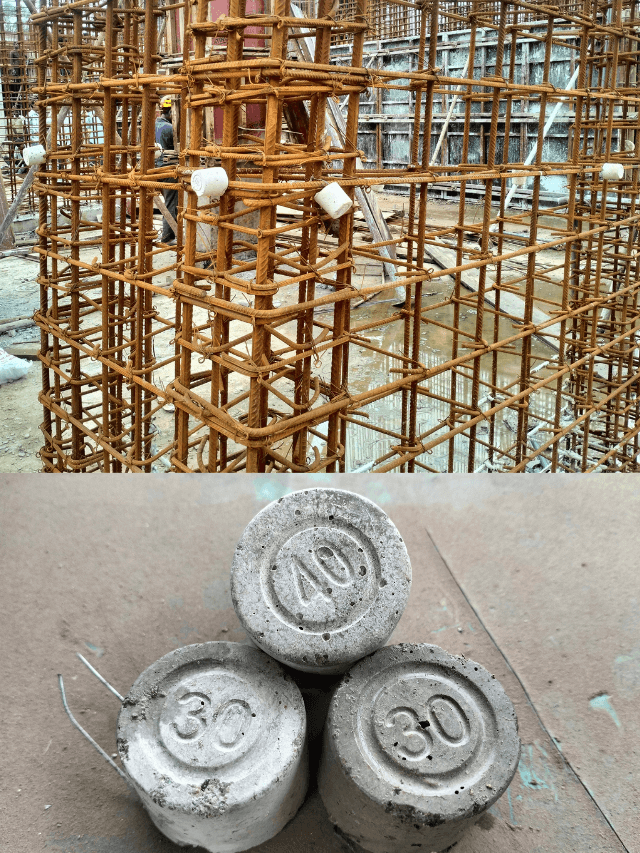Concrete is one of the most versatile and essential construction materials used worldwide. Its strength, durability, low maintenance requirements, and fire resistance make it a preferred choice for various structures, ranging from small residential buildings to massive infrastructure projects like bridges, dams, and skyscrapers. In this blog, we will explore how to accurately calculate the quantity of concrete required for footings, ensuring cost efficiency and minimizing material wastage.
How to calculate the concrete quantity for the footing?

Also read,
AAC Blocks: A Comprehensive Guide to Benefits, Sizes, and Best Practices.
How To Calculate Quantity of Steel Using Unit Weight of Steel bars?
Introduction to Concrete :
Concrete is a proper mixture of cement, sand (fine aggregate), coarse aggregates (like gravel or crushed stone) and water. When mixed it is a fluid paste but over time, through a chemical reaction called hydration, the paste gradually hardens and gains strength, turning into a solid, durable material. Sometimes, admixtures are also added to enhance specific properties like strength, setting time, or workability. When mixed in proper proportions, this combination forms a strong and durable building material used widely in construction.
Due to its high compressive strength, concrete is widely used for load-bearing structures. Its resistance to fire, weather conditions, and environmental factors further enhances its longevity, reducing maintenance costs over time. Whether for roads, buildings, or industrial projects, concrete remains a cornerstone of modern construction.
One of concrete’s greatest advantages is its adaptability. It can be molded into any shape and size, making it ideal for a wide range of construction needs. Additionally, its simple and convenient application allows for easy mixing, pouring, and setting, ensuring efficient construction.
Shivalik Curv: The Twisted Marvel Redefining GIFT City’s Skyline.
Top 10 Civil Engineering Software Tools in 2025.
Importance of accurate concrete calculation :-
Every construction project shares one common goal — minimizing unnecessary expenses. That’s why engineers and consultants are hired: to ensure precision and avoid costly mistakes. Even a single error can lead to significant financial loss. One such critical area is the accurate calculation of concrete quantity.
Precise concrete estimation helps avoid over-ordering, which not only increases costs but also leads to waste disposal challenges and environmental impact. On the other hand, underestimating can cause delays, require additional orders, and extend the project timeline. Accurate quantity calculation ensures efficient material usage, timely workflow, and prevents idle labor or equipment, ultimately contributing to a cost-effective and smooth construction process.
Understanding Footing in Construction :
What is a footing?
A footing is a structural element in construction projects that forms the foundation base of a building. Its primary function is to distribute the load from the structure above (such as columns or walls) to the soil below, ensuring stability and preventing settlement or structural failure.
Also read,
Foundation in Construction: An Introduction to Their Purpose and Importance.
Comprehensive Guide to the Types of Foundations in Construction.
Formula for Calculating Concrete Quantity :
The calculation of concrete quantity is essentially a simple volume calculation of the specific structural element. In the case of footings, which are commonly shaped like a cube or cuboid, the volume can be calculated using the standard formula:
Volume = Length × Width × Depth
This formula gives the volume in cubic meters (m³), which represents the amount of concrete required for the footing.
A Step-by-Step Calculation :
Step 1: Measure the dimensions of the footing.
Step 2: Convert units to a uniform measurement system (meters, feet, etc.).
Step 3: Apply the volume formula for the specific type of footing.
Step 4: Add allowances for wastage and shrinkage.
Example Calculation :-
Here’s a simple and practical example taken from my current job site. Based on the structural drawings, we’ll walk through the step-by-step calculation using real dimensions to help you understand how to accurately calculate the concrete quantity for a footing.

In the figure above, you can see various dimensions and parameters that are crucial for accurately calculating the quantity of concrete required.

The above image is taken from the same site where I work. From this, we can extract the necessary details for calculating the concrete quantity.
Let’s take Footing No. F4 as an example for our calculation:
- Footing No. : F4
- Column Size : 300 mm × 900 mm
- Footing Size : 3650 mm × 3050 mm
- Depth of Footing : 950 mm
Step 1: Convert All Dimensions to Meters
- Length = 3650 mm = 3.65 m
- Width = 3050 mm = 3.05 m
- Depth = 950 mm = 0.95 m
Step 2: Calculate Volume of Footing (Box Type) :
Volume = Length × Width × Depth
= 3.65 × 3.05 × 0.95 = 10.59 m³
Thus, Concrete quantity required for Footing No. F4 is approximately 10.33 m³.

Tips to Optimize Concrete Usage :
Concrete calculation is just the beginning; the real work begins with proper execution. After estimation, it’s crucial to ensure accurate formwork to minimize material wastage, maintain the correct water-cement ratio for long-term durability, and reduce errors through precise measurement and careful supervision during casting.
That’s all for this blog! We’ve seen how to accurately calculate the quantity of concrete required for a box footing based on the drawing. You can use the same method to calculate concrete for other footings as well. However, always remember to add an extra 5–10% to the calculated quantity to account for wastage or any unforeseen issues on site. Construction can be unpredictable, and this buffer ensures you can complete the casting without interruptions or material shortages.
For the material calculation you can use our Concrete Quantity Calculator.
You can also read,
Also read more,
How To Calculate Quantity of Steel Using Unit Weight of Steel bars?
Comprehensive Guide to the Types of Foundations in Construction.
Excavation in Construction: A Comprehensive Guide to Its Process & Types.
Introduction to Civil Engineering: What It Is and Why It Matters.
Follow us on :-
















Hi, I think your site might be having browser compatibility issues. When I look at your website in Safari, it looks fine but when opening in Internet Explorer, it has some overlapping. I just wanted to give you a quick heads up! Other then that, fantastic blog!